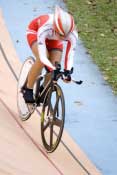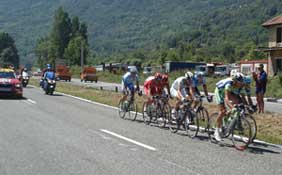Staying Safe on the Road Bicycle Racing
|
Track racing bicycles are light-weight with one gear and no brakes. |
The Tour de France, seen here during the 2008 event, is the world’s most famous bicycle race. The route takes riders throughout France, including steep climbs in the Alps and the Pyrenees. |
Bicycle racing is about as old as the bicycle. The first bicycle racing event took place in the Parc de Saint-Cloud in Paris in 1868. The winner of one of the races, though possibly not the first, was Englishman James Moore (1849-1935), riding a wooden bike with iron tires. A year later Moore won the first road race, from Paris to Rouen. He completed the 130-km (80-mi) distance in 10 hours and 25 minutes. Possibly, he rode a Michaux bicycle, although accounts vary.
Modern bicycle racing has three forms. Track racing takes place on highly banked oval tracks in special arenas called velodromes. Track bicycles are different from other bicycles, with no brakes and only a single gear. Mountain bike racing occurs on cross-country courses and on steep hillside descents. But the best-known form of bicycle racing is road racing.
The world’s most famous road race, the Tour de France, first took place in 1903. In this three-week event, riders compete in daily stages of up to a distance of 260 km (162 mi), riding around France, over the Alps and Pyrenees, and into neighboring countries. Teams of cyclists compete, but there is only one champion. There are two other three-week events, called Grand Tour events—the Italian Giro d'Italia, founded in 1909, and the Spanish Vuelta a España (1935)—and numerous multiday races ranging from 2 to 14 days in length. More common, however, are single-day road races. One classic is Italy’s Milan-San Remo, first run in 1907. With a distance of 294 km (183 mi), it is the longest professional one-day race. The longest single-day cycling race is the Lotoja, covering 332 km (206 mi) from Logan, Utah, to Jackson, Wyoming, in the United States.
Although many road races have a mass start, others are time trials, in which the cyclist races alone against the clock. Time trials are included as stages in the Grand Tour events. Another type of road race is the criterium, in which riders compete on a circuit, usually on city roads. The length of this race may be based on the number of laps to be completed or on a specific amount of time. Because it is much shorter than other types of races and riders keep passing the same spots on different laps—and also because of its sprints and sharp turns—the criterium can be more exciting to watch than other types of races.
The best-known races involve professionals and elite riders, but there are, of course, many open events and many designed for amateurs. The Union Cycliste Internationale (International Cycling Union) sponsors events for both professionals and amateurs on every continent.
Bicycle racers use an unusual technique to conserve energy in long-distance races. The riders cluster together in order to reduce the aerodynamic drag from the air, called drafting off each other. This saves all of them energy except for the leader of the pack. However, each leader holds that position for only a short time before falling back to draft off a new leader. This grouping of riders is known as a peloton. By extension, the word is also used to refer to professional riders in general.
What about the recreational rider who does not race and does not want to compete with traffic? For these cyclists, special paths have been developed. Bike lanes and cycling paths help provide some safety from traffic for riders.
This content has been re-published with permission from SEED. Copyright © 2025 Schlumberger Excellence in Education Development (SEED), Inc.



